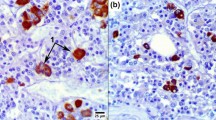Summary
In normal rat adrenals, droplet-like hyaline globules occur in the juxtamedullary and reticular zones. Following methylandrostenediol treatment, mitochondrial changes, droplet-like “globules” formation, “protein-containing vacuoles” of various types and hyaline droplets were observed. The material constituting the contents of the “protein-containing vacuoles” as well as that of hyaline droplets is believed to be derived in part from the blood plasma, in part from the cytoplasm. The findings presented here are believed to support the view that the hyaline droplets and related changes represent non-specific lesions of pathobiotic nature. The hyaline droplets in adrenocortical cells do not represent “secretory granules” inLiebegotts orSelyes sense, though their indirect relationship to the secretory process cannot be excluded.
Zusammenfassung
Schon normalerweise finden sich tropfenartige hyaline Kügelchen in der reticulären und juxtamedullären Zone der Nebennierenrinde von Ratten. Nach der Methylandrostenediolverabreichung wurden Veränderungen an Mitochondrien, Bildung tröpfchenartiger Kügelchen, „eiweißhaltige Vacuolen“ und hyaline Tropfen beobachtet. Das Material des Inhaltes der eiweißhaltigen Vakuolen sowie das der hyalinen Tropfen wird als teilweise vom Blutplasma, teilweise vom Cytoplasma stammend angesehen. Die Befunde unterstützen die Deutung der hyalinen Tropfen und der mit ihnen verwandten Gebilde als unspezifischer Veränderungen pathobiotischer Natur. Hyaline Tropfen in den Nebennierenrindenzellen stellen also doch wohl nicht „Sekrettr6pfehen“ im SinneLieSegotts odorSelyEs dar, ihr indirekter Zusammenhang mit dem sekretorischen Prozeß kann jedoch nicht ausgeschlossen werden.
Similar content being viewed by others
References
Altmann, H.W.: Allgemeine morphologische Pathologie des Cytoplasmas. Die Pathobiosen. In: Handbuch der allgemeinen Pathologie, ed. byBüchner-Letterer-Roulet, Bd. II/1, Das Cytoplasma. Berlin-Göttingen-Heidelberg: Springer 1955. There additional references.
—, u.U. Osterland: Über cytoplasmatische Wirbelbildungen in den Leberzellen der Ratte bei chronischer Thioacetamidvergiftung. Beitr. path. Anat.124, 1–18 (1961).
Bachmann, R.: Die Nebenniere. In:W. v. Möllendorf, Handbuch der mikroskopischen Anatomie des Mensehen, Bd. VI, Teils. Berlin-Göttingen-Heidelberg: Springer 1954.
Crane, W. A. J., R. E. Porter andD. J. Ingle: Pathologic changes in sensitized rats treated with methylandrostenediol and with growth hormone. Endocrinology63, 43–56 (1958).
DeRobertis, E.D.P., andD. Sabatini: Mitochondrial changes in adrenal cortex of normal hamsters. J. biophys. biochem. Cytol.4, 667–668 (1958).
Ehrenbrand, F.: Sind die sogenannten „fuchsinophilen“ Zellen der Nebennierenrinde spezifische Androgenbildner? Acta histochem. (Jena)7, 1–73 (1959).
Fujita, H.: An electron microscopic study of the adrenal cortical tissue of the domestic fowl. Z. Zellforsch.55, 80–88 (1961).
Gansler, H., etCh. Rouiller: Modifications physiologiques et pathologiques du chondriome. Schweiz. Z. Path.19, 217–243 (1956).
Legait, H., etE. Legait: Étude comparée du Mérion et du rat blanc à l'état normal et dans diverses conditions expérimentales. C.R. Soc. Biol. (Paris)154, 2111–2113 (1960).
Lever, J.D.: Physiologically induced changes in adrenocortical mitochondria. J. biophys. biochem. Cytol.2, 313–317 (1956).
Liebegott, G.: Studien zur Orthologie und Pathologie der Nebennieren. Beitr. path. Anat.109, 1–93 (1944).
—: Die Pathologie der Nebennieren. Verh. dtsch. Ges. Path.36, 21–68 (1952).
Loustalot, P.: Über das Vorkommen von PAS positiven Tröpfchen in der Nebennierenrinde der Ratte. Schweiz. Z. Path.20, 716–723 (1957).
Luft, J., andO. Hechter: An electron microscopic correlation with function in the isolated perfused cow adrenal. J. biophys. biochem. Cytol.3, 615–620 (1957).
Motlík, K., andM. Janoušková: Hyaline droplet formation in the adrenal gland [Tschechisch]. Acta Univ. Carol. Med. (Praha)2, 123–146 (1960).
Müller., J., andF. Chytil: An introduction into protein histochemistry [Tschechisch]. Praha: SZN 1962.
Pearse, A.G.E.: Histochemistry, Theoretical and Applied. London: Churchill 1960.
Rather, L.J.: Adrenal cortical and medullary changes in experimental renal hypertension. Amer. J. Path.27, 717–718 (1951).
Salgado, E., andH. Selye: The production of hypertension, nephrosclerosis and cardiac lesions by MAD treatment in the rat. Endocrinology55, 550–560 (1954).
——: Hormonal factors in the production of experimental renal and cardiovascular disease. J. Lab. clin. Med.45, 237–246 (1955).
Schultz, R. L., andR.K. Meyer: Cytochemical characterization of the granules in zona glomerulosa of the bovine adrenal gland. J. cell. comp. Physiol.52, 1–12 (1958).
Schwarz, W., H.J. Merker u.G. Suchowsky: Elektronenmikroskopische Untersuchungen über die Wirkung von ACTH und Stress auf die Nebennierenrinde der Ratte. Virchows Arch. path. Anat.335, 165–179 (1962).
Selye, H., andE. Salgado: PAS-tingible bodies in the adrenocortical cells of rats treated with various steroid hormones. Acta anat. (Basel)24, 197–207 (1955).
—, andH. Stone: On the experimental morphology of the adrenal cortex. Springfield (Ill.): Ch. C. Thomas 1950.
Skelton, F.R.: The production of hypertension, nephrosclerosis and cardiac lesions by methylandrostenediol treatment in the rat. Endocrinology53, 492–505 (1953).
—: Experimental hypertensive vascular disease accompanying adrenal regeneration in the rat. Amer. J. Path.32, 1037–1053 (1956).
Spargo, B., F. Straus andF. Fitch: Zonal renal papillary droplet change with potassium depletion. Arch. Path.70, 599–613 (1960).
Stutinsky, F.: Production expérimentale de colloide dans le cortex surrénal du rat. Ann. Endocr. (Paris)16, 900–904 (1955).
Yamori, T., S. Matsuura andS. Sakamoto: An electron microscopic study of the normal and stimulated adrenal cortex in the rat. Z. Zellforsch.55, 179–199 (1961).
Author information
Authors and Affiliations
Rights and permissions
About this article
Cite this article
Motlík, K., Janoušková, M. “Hyaline droplet” formation and some other adrenocortical changes following methylandrostenediol treatment in the rat. Virchows Arch. path Anat. 336, 427–446 (1963). https://doi.org/10.1007/BF00973026
Received:
Issue Date:
DOI: https://doi.org/10.1007/BF00973026




